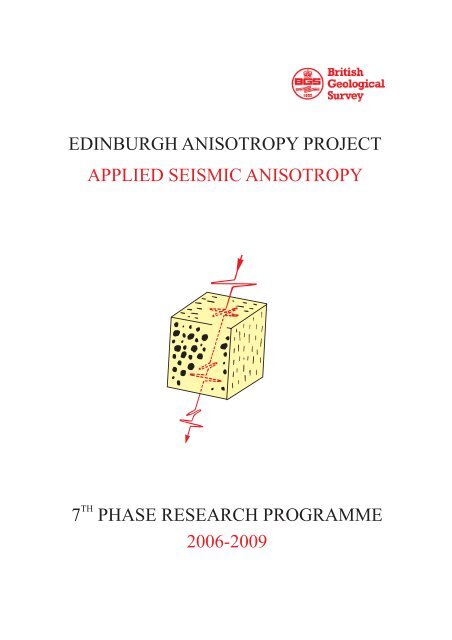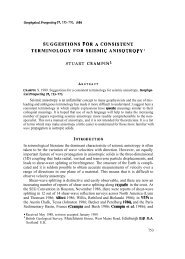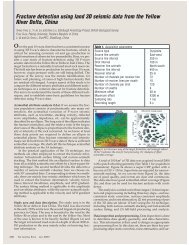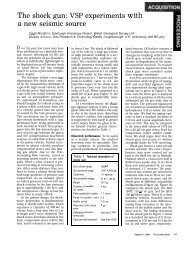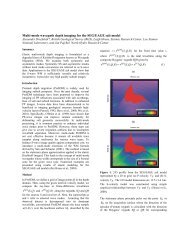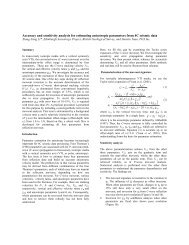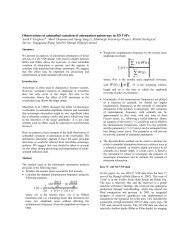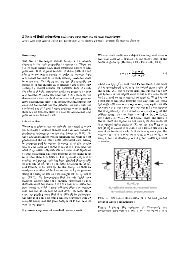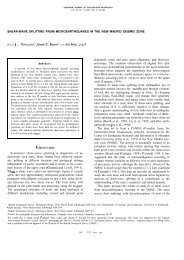edinburgh anisotropy project applied seismic anisotropy 7 phase ...
edinburgh anisotropy project applied seismic anisotropy 7 phase ...
edinburgh anisotropy project applied seismic anisotropy 7 phase ...
You also want an ePaper? Increase the reach of your titles
YUMPU automatically turns print PDFs into web optimized ePapers that Google loves.
EDINBURGH ANISOTROPY PROJECT<br />
APPLIED SEISMIC ANISOTROPY<br />
TH<br />
7 PHASE RESEARCH PROGRAMME<br />
2006-2009
THE EDINBURGH ANISOTROPY PROJECT<br />
APPLIED SEISMIC ANISOTROPY<br />
7 TH PHASE RESEARCH PROGRAMME 2006-2009<br />
EXCUTIVE SUMMARY<br />
The Edinburgh Anisotropy Project (EAP) conducts research into <strong>applied</strong> <strong>seismic</strong> <strong>anisotropy</strong>, and how<br />
to utilize such information for the understanding of hydrocarbon reservoirs. EAP is supported by a<br />
consortium of major oil, service and software companies. The EAP research programme is guided by<br />
industry requirements and is primarily focused on fracture characterization and <strong>anisotropy</strong> imaging.<br />
The programme covers a wide variety of topics including data processing, interpretation, modelling<br />
and acquisition design, as well as fundamental wave propagation issues.<br />
EAP was established in July 1988 with seventeen years of experience in <strong>seismic</strong> <strong>anisotropy</strong>. EAP has<br />
organised its research programme in three-year <strong>phase</strong>s. The <strong>project</strong> is now in its 6 th Phase, which ends<br />
in June 2006.<br />
The 7 th Phase Research Programme (2006-09)<br />
The programme proposed for the 7 th Phase is a continuation of the 6 th Phase, but with a particular<br />
emphasis on frequency-dependent <strong>anisotropy</strong>, arising from discussions with sponsors. The<br />
programme has three components:<br />
o AVD technology for fracture characterization<br />
Extension of traditional AVD (attributes versus direction) methods to exploit frequencydependent<br />
<strong>anisotropy</strong> for robust fracture density information together with fluid saturation and<br />
dominant scale length<br />
o Converted-wave analysis for improved imaging of reservoir structure<br />
Extension of current converted-wave imaging tools (e.g. CXtools) to account for diodic<br />
converted-wave effects and further development of depth-imaging tools for building a common<br />
anisotropic earth model<br />
o Anisotropic rock physics for analysing frequency-dependent <strong>anisotropy</strong><br />
Progress towards gaining more insights into the information content of frequency-dependent<br />
<strong>anisotropy</strong> through experimental studies, calibrated theoretical developments and analysis of<br />
time-lapse VSP data<br />
An important aspect of EAP research is that the development of theory, methodology and algorithms<br />
is combined with application to real data, supplied by the sponsors, to demonstrate the value of the<br />
technology produced.
Deliverables and Technology Transfer<br />
o Research results in the form of annual reports, technical papers and software releases<br />
o Courses on <strong>applied</strong> <strong>seismic</strong> <strong>anisotropy</strong>, tailored to individual sponsor’s requirements<br />
o Special consultancy and joint studies of company-specific <strong>anisotropy</strong>-related issues<br />
o PhD research studentships<br />
EAP believes in maintaining close links with each member of the consortium so that the technology<br />
developed is transferred efficiently, and the research programme remains dynamic and evolutionary.<br />
Fees<br />
For the 7 th Phase the annual fees will be set at a flat rate of £31k.<br />
For new sponsors there is, in addition to the annual subscription, a joining fee of £30k, or £10k plus<br />
some negotiable equivalent in the form of software or data.<br />
Meetings<br />
The main annual EAP Technical and Business Meeting is held in Edinburgh, usually immediately<br />
following the annual EAGE conference. A further meeting is held at the annual SEG conference.<br />
Consortium members<br />
EAP is currently sponsored by eighteen service and oil companies and one software company: Agip,<br />
BG, BGP, BP, Chevron, CNPC, ConocoPhillips, ExxonMobil, GX Technology, KerrMcGee,<br />
Marathon, Norsk Hydro, PDVSA, Schlumberger, Shell, SinoPec, Total, Veritas DGC and Landmark.<br />
Project Resources<br />
Staff: A team of 5 scientific staff and 6 PhD students (see Appendix A).<br />
Computing: a 24-node PC cluster, Sun Ultrasparc/Sparc Workstations, Intel-Based destop PCs,<br />
Terabyte Raid System For Data Storage.<br />
Datasets: EAP benefits from access to datasets supplied by the sponsors. A list of the datasets<br />
available to the <strong>project</strong> during the 6 th Phase is given in Appendix B.<br />
Further Information<br />
Enquiries about EAP activities and membership details should be addressed to:<br />
Professor Xiang-Yang Li, Technical Director<br />
Edinburgh Anisotropy Project, British Geological Survey,<br />
Murchison House, West Mains Road, Edinburgh EH9 3LA, UK<br />
Tel: +44 (0)131 667 1000/Fax: +44 (0)131 667 1877/E-mail: xyl@bgs.ac.uk<br />
Further information can also be found at http://www.eap.bgs.ac.uk
7 th PHASE RESEARCH PROGRAMME<br />
Introduction<br />
During the 6 th Phase (2003-2006), we have focused on consolidating our ideas and findings for<br />
technology transfer. This led to the release of three software packages, i.e. CXtools for convertedwave<br />
imaging, RU for rock physics and fracture modelling, and GeoLab for depth model building and<br />
imaging. Major progress has been made in the following areas in the past five years:<br />
o Converted-waves analysis<br />
- New theories and algorithms for converted-wave imaging are consolidated into CXtools,<br />
which makes it possible to perform anisotropic imaging with high accuracy but low cost<br />
- A number of successful case studies (e.g. Lomond 2D 4C data, Afflect 3D 4C data)<br />
- Ideas for decoupled migration to perform multiwave type prestack depth imaging<br />
o Fracture characterization<br />
- Frequency-dependent P- and S-wave attributes to characterize fluid saturation and dominant<br />
scale length<br />
- A number of successful case studies (e.g. Clair and Emilio 3D 4C data )<br />
o Time-lapse <strong>seismic</strong> data analysis<br />
- Improved dynamic rock physical model with multi-scale fluid flow<br />
- Ideas of frequency-dependent time-lapse <strong>anisotropy</strong> for discriminating the effects of pore<br />
pressure and saturation<br />
These developments have been endorsed and well received by all sponsors. During this Phase, EAP<br />
has also attracted a record number of sponsors, which encourages us to continue developing our work<br />
through real data applications during the next <strong>phase</strong> from 2006 to 2009, with a primary focus on<br />
integrated studies and the delivery of user-friendly tools.<br />
EAP activities seek to address the needs of industry (fractures, converted waves, imaging in<br />
complex areas), while retaining a component of basic strategic science for future developments<br />
(frequency-dependent <strong>anisotropy</strong>, fluid flow). It is EAP’s intention to achieve a healthy balance<br />
between <strong>applied</strong> and basic research as well as ‘blue-sky’ research.<br />
In addition to the industrial sponsorship, every year EAP also receives matching funds from the<br />
Natural Environment Research Council through its science budget. This provides great value for<br />
money for EAP’s members. From time to time EAP also receives government grants through<br />
competitive tender and review exercises. These matching funds and research grants enable us to carry<br />
out more basic and curiosity-driven research. As a whole, EAP research builds on a solid foundation<br />
of theoretical expertise and field-data analysis in <strong>seismic</strong> <strong>anisotropy</strong> developed over the past<br />
seventeen years. The following sections describe the major components of the 7 th Phase programme.
Converted wave analysis<br />
Interest in converted-waves was rekindled by the emergence of 4C OBC technology in the mid<br />
1990’s. Since then, more than a decade has elapsed. Despite an intensive effort in research and<br />
development of the converted-wave technology, the anticipated breakthrough into a mainstream<br />
technology has still to be realized. A general consensus is that the processing and interpretation of<br />
converted-wave data appears to lag behind the corresponding acquisition technology that has evolved<br />
from analogue phones to digital sensors, from line receivers to point receivers, from dragged cables to<br />
permanently installed trench-buried systems. The difficulties in processing the converted waves lie in<br />
two main areas. In onshore applications, the near-surface is still the main obstacle for obtaining highquality<br />
and high resolution converted-wave data; whilst offshore, converted-wave imaging suffers<br />
from the wide occurrence of <strong>anisotropy</strong> in marine sediments together with the asymmetric raypaths<br />
and the diodic velocity effects due to shallow inhomogeneities, which has even made the data<br />
acquired with permanently installed systems un-interpretable. Due to these problems, there is a<br />
general lack of user-friendly and reliable tools for processing and interpreting the converted-waves.<br />
Since the onset of Phase 5 (2000-03), we have made significant progress in bridging the above gap for<br />
converted-wave imaging. During Phase 5 (2003-03), we have developed a common theoretical<br />
framework to describe the converted-wave behaviour in anisotropic media in terms of convertedwavefield<br />
attributes. This paved the way for the use of standard procedures such as semblance<br />
analysis and Kirchhoff summation to implement converted-wave anisotropic processing with high<br />
accuracy but low cost. During Phase 6 (2003-06), we extended the previous developments into 3D-<br />
4C data for both anisotropic imaging and parameter estimation, and consolidated our achievement<br />
into an user-friendly software, referred to as CXtools. Using this tool, we have reprocessed a number<br />
of 2D and 3D-4C dataset from the North Sea , and in each case, a substantially improved subsurface<br />
image was obtained that has made significant impact on the development of the relevant oilfield.<br />
During Phase 7, our emphasis is to extend CXtools to account for the diodic converted-wave effects<br />
and further development of our depth-imaging tools for building a common anisotropic earth model,<br />
and our aim is to fill the wide acknowledged gap in converted-wave processing with CXtools.<br />
Areas of interest and deliverables for the 7 th Phase:<br />
o diodic decomposition for 3D 4C data;<br />
o the corresponding depth imaging work flows using PP-independent PS imaging approach;<br />
o decoupled migration and associated work flows for anisotropic inversion;<br />
o conversion point signature from 3D 4C data;<br />
o anisotropic estimation in TTI media;<br />
o case studies of 3D-4C data from permanently installed systems in the North Sea;<br />
o user-friendly fully-documented algorithms/software for PC cluster.<br />
Datasets available for the 7 th Phase:<br />
o Valhall LoFS (Life of Field Seismic) 3D-4C data, North Sea;<br />
o BG 4C data<br />
o Shenli 3D-3C data, Yellow River Delta
TH<br />
7 PHASE RESEARCH PROGRAMME<br />
CONVERTED-WAVE ANALYSIS<br />
2006-09<br />
Research developments<br />
-Diodic PS decomposition for building a<br />
common earth model from 3D-4C data<br />
- Anisotropic estimation in orthorhombic<br />
or TTI media<br />
- Optimizing anisotropic depth model<br />
through a prestack time migration<br />
- Case studies of 3D 4C <strong>seismic</strong> data<br />
- User-friendly algorithms and software<br />
CXtools for anisotropic model building<br />
Affleck: EAP Line 60, through Tor penetration (PS data in PP time)<br />
(a) EAP processing<br />
Tor<br />
Top Tor Tie<br />
(b) isotropic/conventional<br />
The Afflect 3D-4C experience (courtesy of KerrMcGee): (a) Reprocessed by<br />
EAP using the Cxtools; and (b) conventional isotropic processing.
AVD technology for fracture characterization<br />
EAP has pioneered the use of <strong>seismic</strong> <strong>anisotropy</strong> for characterization of natural fractured reservoirs.<br />
Currently, we are extending our expertise to go beyond what the conventional <strong>anisotropy</strong> concept for<br />
fracture imaging can offer by developing innovative methods to evaluate the dominant scale length<br />
from 3D VSP, 3D surface and 3D 4C-OBC <strong>seismic</strong> data. Our new theories and methods allow the<br />
<strong>seismic</strong> response across a broad band of <strong>seismic</strong> frequencies to be computed, making it possible to<br />
observe and analyse the directional spectral/dispersion/attenuation variation and frequency-dependent<br />
<strong>anisotropy</strong> in <strong>seismic</strong> data and then to invert these variations for the properties of the fracture<br />
distribution. This will require advanced techniques for extracting spectral/dispersion and attenuation<br />
characteristics from <strong>seismic</strong> data using, for example, multi-instantaneous attribute analysis and<br />
modern spectral decomposition techniques.<br />
EAP is also developing advanced numerical methods to simulate wave propagation in media with<br />
discrete fracture systems using the discrete dynamic rock physics model, which allows us to develop<br />
inversion techniques to obtain information about discrete formation or meso-scale fractures. The work<br />
so far focused on 2D will be extended to 3D with an aim to develop a discrete fracture network (DFN)<br />
model by using <strong>seismic</strong> <strong>anisotropy</strong> attributes as inputs to combine with other geological/ geophysical<br />
data.<br />
Areas of interest and deliverables for the 7 th Phase:<br />
o Characteristics of directional dispersion/spectral/attenuation variations in P- and converted-wave<br />
data and their applications for determining fracture properties such as the dominant scale length,<br />
and fluid saturation;<br />
o Generation of realistic fracture networks and patterns at the meso-scale for <strong>seismic</strong> modelling, and<br />
computation of 3D synthetic VSP and reflection dataset using realistic reservoir models with<br />
discrete fracture distributions;<br />
o Analysis and inversion procedure to quantify fracture size and fracture porosity (storability) from<br />
3D VSP, 3D surface and 3D-4C OBC data including both synthetic and real data;<br />
o Multi-Attribute Analysis, including coherency analysis, multi-component instantaneous<br />
polarization analysis, and spectral decomposition of <strong>seismic</strong> data to reveal anomalies that are<br />
related subsurface fracture distributions;<br />
o Comprehensive software packages for fracture modelling and <strong>seismic</strong> imaging including<br />
enhanced 3D modelling capability to simulate <strong>seismic</strong> wave propagation in fractured media and<br />
software to extract information on fracture properties (size/storability, density, orientations, and<br />
fluid properties).<br />
Datasets available for the 7 th Phase:<br />
o Emilio 3D 4C <strong>seismic</strong> dataset<br />
o The Clair field OBC data and associated VSPs<br />
o Physical modeling 3D datasets (CNPC Key Labs)<br />
o Wind River 3D surface data.
TH<br />
7 PHASE RESEARCH PROGRAMME<br />
Fracture characterization<br />
2006-09<br />
Research developments<br />
- Analysis of P-wave attenuation <strong>anisotropy</strong>/shear-wave splitting<br />
- Dominant scale length and fluid saturation from 3D-4C <strong>seismic</strong><br />
- Techniques for modeling the <strong>seismic</strong> response of large fractures<br />
- multi-scale decomposition and attributes analysis<br />
- analysis procedures/user-friendly algorithms & software<br />
Azimuthal frequency anomalies in 3D <strong>seismic</strong> data<br />
East-west azimuth<br />
North-south azimuth<br />
Wind River Basin (Queen and Lynn 2003)<br />
0.44<br />
39.039.239.439.639.8<br />
0.46<br />
Ti me<br />
0.48<br />
0.50<br />
Frequency-independent Frequency-dependent Perpendicular Parallel<br />
0.52
Anisotropic rock physics for frequency-dependent <strong>anisotropy</strong><br />
Frequency-dependent geophysical properties have attracted more and more interests from the research<br />
communities and the industry, which potentially links the subsurface <strong>seismic</strong> response to permeability<br />
and the dominant scale length of the heterogeneities in the subsurface. The situation regarding this<br />
subject is comparable to that of research on <strong>seismic</strong> <strong>anisotropy</strong> in the 80’s: the potential is high yet<br />
more work needs to be done towards both the understanding of the phenomenon and its implications.<br />
During the 6 th Phase, we have developed a dynamic rock physical model accounting for changes in<br />
both pore pressure and saturation. A range of observable effects was predicted, including the<br />
frequency dependence of shear-wave time delays, differential attenuation between fast and slow<br />
shear-waves and P-wave attenuation <strong>anisotropy</strong>. We have analysed a series of VSP datasets in order<br />
to evaluate these effects, including multicomponent VSPs, walkway VSPs and time-lapse VSPs.<br />
These studies have confirmed that these effects are detectable in field data and can be related to<br />
fracture properties such as dominant scale length and fluid saturation, using robust modelling and<br />
inversion procedures.<br />
Phase 7 will develop these ideas across a spectrum of activities, encompassing further theoretical<br />
development, laboratory calibration, development of processing techniques and application to field<br />
data. The goal of the research will be to use the modern ideas in spectral decomposition and<br />
poroelastic theory to establish a robust link between <strong>seismic</strong> <strong>anisotropy</strong> and the petrophysical<br />
properties of rock, particularly the anisotropic variation of permeability. We will continue to analyse<br />
VSP surveys including time-lapse VSP data, to consolidate our understanding, but the new direction<br />
of Phase 7 will be the emphasis on applying our ideas to surface <strong>seismic</strong> data.<br />
Areas of interest and deliverables for the 6 th <strong>phase</strong><br />
o improved rock physics models, calibrated against field and laboratory data, which relate the<br />
frequency dependent anisotropic response to fracturing, fluid saturation and stress state;<br />
o finite difference modeling for wave propagation through a discrete fracture network, to establish<br />
the effect of scattering from fractures of different sizes on the anisotropic response;<br />
o use of attenuation measurements for reservoir characterisation, in particular a comprehensive<br />
theory for interpretation of azimuthal AVO in the presence of frequency dependent <strong>anisotropy</strong>;<br />
o Analysis of time-lapse multi-azimuth VSP data to establish the relationship between the<br />
anisotropic <strong>seismic</strong> response and pressure and saturation variations.<br />
o a fully tested comprehensive rock physics subroutine library<br />
Datasets available for the 6 th Phase:<br />
o Laboratory measurements of synthetic fractured rocks with known fracture geometries<br />
o Multi-azimuths VSPs from the Wyoming Basin<br />
o Time lapse 3D VSPs from Weyburn<br />
o Time lapse VSPs from Quarnalam/PDO.
APPENDIX A – PROJECT PERSONNEL<br />
The EAP team presently comprises five members of BGS staff, a senior consultant in the Unversity of<br />
Edinburgh, and six PhD Students. It also benefits from its close association with BGS staff working in<br />
other areas of seismology, and associated academic staff in the University of Edinburgh.<br />
EAP Staff<br />
Technical director:<br />
Professor Xiang-Yang Li (Multicomponent seismology)<br />
Principal Geophysicist:<br />
Dr. Enru Liu (Associate director and Fracture imaging)<br />
Senior Geophysicists:<br />
Dr. Hengchang Dai (Anisotropic imaging)<br />
Dr. Mark Chapman (Rock physics model and fluid-rock interaction)<br />
Senior Consultant:<br />
Professor Stuart Crampin (Fundamentals of <strong>anisotropy</strong>)<br />
(University of Edinburgh)<br />
Associated Staff<br />
Senior Seismologist:<br />
Technical Engineer:<br />
Dr David Booth (Project support)<br />
Mr Brian Bainbridge (Technical and computing support)<br />
Associated Academics<br />
University of Edinburgh:<br />
Professor Ian Main (Rock Physics)<br />
Dr Roger Scrutton (Log data intepretation)<br />
Dr Andrew Curtis (Exploration seismology)<br />
EAP Students<br />
Jinghua Zhang (4C <strong>seismic</strong> and converted-wave)<br />
Lifeng Wang (4C <strong>seismic</strong> and fractures)<br />
Isabel Varela (Fracture modelling)<br />
Zhongping Qian (4C <strong>seismic</strong> and fractures)<br />
Adam Wilson (Frequency-dependent <strong>anisotropy</strong>)<br />
Joao Marcos Ferreira (Micro <strong>seismic</strong> monitoring)
APPENDIX B - EAP ACTIVITIES AND DATASETS<br />
Converted-waves COMPLETED ONGOING PROMISED<br />
Marine 4C <strong>seismic</strong>s<br />
BP – Valhall(2D)<br />
Agip – Johnd Field 2D<br />
BP - Lomond 2D<br />
Agip – Emilio 3D 4C<br />
BG – 4C<br />
BP-Vauhall Life<br />
of Field Seismic<br />
Mahagony 2D<br />
Chevron Alba 2D<br />
Afflect 3D 4C<br />
Shell – Guilemot 2D<br />
Chevron – Alba 3D<br />
Land 3C data Changqing 2D SinoPec 3D 3C<br />
Petro-China 2D 3C<br />
Offset VSPs/<br />
3D VSPs<br />
PetroChina – Ordos<br />
VSPs<br />
Fractures COMPLETED ONGOING PROMISED<br />
Agip – Emilio 3D<br />
Clair – 3D 4C<br />
Marine 4C <strong>seismic</strong>s<br />
2D/3D <strong>seismic</strong>s<br />
Saga 2D (Geophone<br />
coupling)<br />
Shell – Guilemot 2D<br />
Shenli 3D wide azimuth<br />
Fina – 2D +3D lines<br />
Norsk hydro<br />
Grange 3D<br />
Physical modelling 3D wide DOE – Wyoming;<br />
azimuth data<br />
wind river basin<br />
Walkaway VSPs /<br />
3D VSPs<br />
Bluebell – VSPs<br />
San Juan Basin VSPs<br />
NW Colorado VSPs<br />
BP Clair VSP<br />
BP Egypt VSP<br />
TIME LAPSE<br />
SEISMIC<br />
Repeat VSPs/<br />
COMPLETED ONGOING PROMISED<br />
Mobil – Camelot<br />
Shell – Quarn Alam<br />
Weyburn VSPs<br />
Saga –Snorre, 15 nearoffset<br />
VSPs<br />
Micro-<strong>seismic</strong>ity<br />
USGS micro<strong>seismic</strong>ity<br />
data<br />
Marine 4C <strong>seismic</strong>s Teal South 3D Vauhall LoFS data<br />
COMPLEX AREAS COMPLETED ONGOING PROMISED<br />
Surface <strong>seismic</strong> Amera Hess – long offset Marathon 3D<br />
two-boat shoot (Flare)<br />
Veritas DGC - 12km<br />
cable<br />
Low frequency data Texaco-2D lines<br />
Veritas – 2D lines


